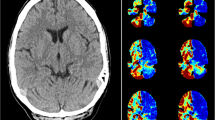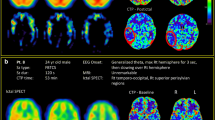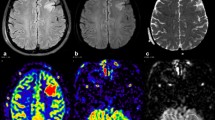Abstract
Introduction
Postictal (“Todd’s”) paralysis, or “epileptic hemiplegia,” is a well-known complication of focal or generalized epileptic seizures. However, it is unclear whether the pathophysiology of Todd’s paralysis is related to alterations in cerebral perfusion. We report CT perfusion findings in a patient presenting with postictal aphasia and right hemiparesis.
Methods
A 62-year-old woman with a history of alcohol abuse, closed head injury and posttraumatic epilepsy, presented with acute onset aphasia and right hemiparesis. A non-contrast head CT scan demonstrated no acute hemorrhage. Left hemispheric ischemia was suspected, and the patient was considered for acute thrombolytic therapy. MRI revealed a subtle increase in signal intensity involving the left medial temporal, hippocampal and parahippocampal regions on both T2-weighted FLAIR and diffusion-weighted sequences. CT angiography and CT perfusion study were performed. The CT perfusion study and CT angiography demonstrated a dramatic reduction in cerebral blood flow and blood volume involving the entire left hemisphere, but with relative symmetry of mean transit time, ruling out a large vessel occlusion.
Results
Clinical resolution of the aphasia and hemiparesis occurred within a few hours, and correlated with normalization of perfusion to the left hemisphere (detected by MR perfusion).
Conclusion
This unique case is the first in which clinical evidence of Todd’s paralysis has been correlated with reversible postictal hemispheric changes on CT and MR perfusion studies. This is important because CT perfusion study is being used more and more in the diagnosis of acute stroke, and one needs to be careful to not misinterpret the data.

Similar content being viewed by others
References
Bravais LF (1827) Recherches sur les symptômes et le traitement de l’épilepsie hémiplégique. Faculté de Médecine, Paris
Todd RB (1849) On the pathology and treatment of convulsive diseases. London Med Gazette 8:661–671, 724–729, 766–772, 815–822, 837–846
Todd RB (1855) Clinical lectures on paralysis, disease of the brain, and other affections of the nervous system. Lindsay & Blakiston, Philadelphia
Binder DK (2004) A history of Todd and his paralysis. Neurosurgery 54(2):480–486
Reynolds EH (2004) Todd, Faraday, and the electrical basis of epilepsy. Epilepsia 45(8):985–992
Jackson JH (1881) On temporary paralysis after epileptiform and epileptic seizures; a contribution to the study of dissolution of the nervous system. Brain 3:433–451
Gowers WR (1901) Epilepsy and other chronic convulsive diseases: their causes, symptoms, and treatment, 2nd edn. Churchill, London
Weinand ME, Carter LP, El-Saadany WF, Sioutos PJ, Labiner DM, Oommen KJ (1997) Cerebral blood flow and temporal lobe epileptogenicity. J Neurosurg 86:226–232
Fisher RS, Schachter SC (2000) The postictal state: a neglected entity in the management of epilepsy. Epilepsy Behav 1:52–59
Meyer JS, Portnoy HD (1959) Postepileptic paralysis: a clinical and experimental study. Brain 82:162–185
Efron R (1961) Post-epileptic paralysis: theoretical critique and report of a case. Brain 84:381–394
Kellinghaus C, Kotagal P (2004) Lateralizing value of Todd’s palsy in patients with epilepsy. Neurology 62(2):289–291
Gallmetzer P, Leutmezer F, Serles W, Assem-Hilger E, Spatt J, Baumgartner C (2004) Postictal paresis in focal epilepsies—incidence, duration, and causes: a video-EEG monitoring study. Neurology 62(12):2160–2164
Adam C, Rouleau I, Saint-Hilaire JM (2000) Postictal aphasia and paresis: a clinical and intracerebral EEG study. Can J Neurol Sci 27(1):49–54
Parmar H, Lim SH, Tan NC, Lim CC (2006) Acute symptomatic seizures and hippocampus damage: DWI and MRS findings. Neurology 66(11):1732–1735
Lazeyras F, Blanke O, Zimine I, Delavelle J, Perrig SH, Seeck M (2000) MRI, (1)H-MRS, and functional MRI during and after prolonged nonconvulsive seizure activity. Neurology 55(11):1677–1682
El-Koussy M, Mathis J, Lovblad KO, Stepper F, Kiefer C, Schroth G (2002) Focal status epilepticus: follow-up by perfusion- and diffusion MRI. Eur Radiol 12(3):568–574
Kim JA, Chung JI, Yoon PH, Kim DI, Chung TS, Kim EJ, Jeong EK (2001) Transient MR signal changes in patients with generalized tonicoclonic seizure or status epilepticus: periictal diffusion-weighted imaging. AJNR Am J Neuroradiol 22(6):1149–1160
Oh JB, Lee SK, Kim KK, Song IC, Chang KH (2004) Role of immediate postictal diffusion-weighted MRI in localizing epileptogenic foci of mesial temporal lobe epilepsy and non-lesional neocortical epilepsy. Seizure 13(7):509–516
Salih MA, Kabiraj M, Al-Jarallah AS, El Desouki M, Othman S, Palkar VA (1997) Hemiconvulsion-hemiplegia-epilepsy syndrome. A clinical, electroencephalographic and neuroradiological study. Childs Nerv Syst 13(5):257–263
Higuchi T, Inaba Y, Hata Y, Seki C, Ichikawa M (1998) MRI, SPECT and MRS findings in a case of acute hemiplegia syndrome with a marked hemispheric brain edema. No To Hattatsu 30(5):403–409
Nelissen N, Van Paesschen W, Baete K, Van Laere K, Palmini A, Van Billoen H, Dupont P (2006) Correlations of interictal FDG-PET metabolism and ictal SPECT perfusion changes in human temporal lobe epilepsy with hippocampal sclerosis. Neuroimage 32(2):684–695
Helmchen C, Steinhoff BJ, Dichgans M (1994) Variants of Todd’s paralysis: postictal apraxia and prolonged postictal hemineglect. Nervenarzt 65(10):700–703
Bansal SK, Chopra JS (1991) Reversible postictal ataxic hemiparesis. Ital J Neurol Sci 12(1):75–79
Salmon JH (1968) Transient postictal hemianopsia. Arch Ophthalmol 79(5):523–525
Kosnik E, Paulson GW, Laguna JF (1976) Postictal blindness. Neurology 26(3):248–250
Leutmezer F, Podreka I, Asenbaum S, Pietrzyk U, Lucht H, Back C, et al (2003) Postictal psychosis in temporal lobe epilepsy. Epilepsia 44(4):582–590
Zeman AZ, Boniface SJ, Hodges JR (1998) Transient epileptic amnesia: a description of the clinical and neuropsychological features in 10 cases and a review of the literature. J Neurol Neurosurg Psychiatry 64(4):435–443
Tassinari CA, Ciarmatori C, Alesi C, Cardinaletti L, Salvi F, Rubboli G et al (1991) Transient global amnesia as a postictal state from recurrent partial seizures. Epilepsia 32(6):882–885
Helmstaedter C, Elger CE, Lendt M (1994) Postictal courses of cognitive deficits in focal epilepsies. Epilepsia 35(5):1073–1078
Maheu G, Adam C, Hazemann P, Baulac M, Samson S (2004) A case of postictal transient anterograde and retrograde amnesia. Epilepsia 45(11):1459–1460
Conflict of interest statement
We declare that we have no conflict of interest.
Author information
Authors and Affiliations
Corresponding author
Rights and permissions
About this article
Cite this article
Mathews, M.S., Smith, W.S., Wintermark, M. et al. Local cortical hypoperfusion imaged with CT perfusion during postictal Todd’s paresis. Neuroradiology 50, 397–401 (2008). https://doi.org/10.1007/s00234-008-0362-1
Received:
Accepted:
Published:
Issue Date:
DOI: https://doi.org/10.1007/s00234-008-0362-1




